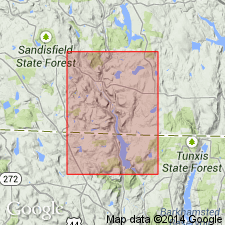
- Usage in publication:
-
- Mt. Prospect complex
- Modifications:
-
- Named
- Dominant lithology:
-
- Gneiss
- Quartzite
- Schist
- Norite
- Granite
- AAPG geologic province:
-
- New England province
Summary:
The Mt. Prospect Complex includes three major groups of widely differing rock types. Oldest includes metasedimentary mica gneisses, mica quartzites, and quartz-mica schists of Hartland and Berkshire formations; the Mount Tom hornblende gneiss; an assemblage of diorite gneisses (previously known as Brookfield diorite) comprising bulk of complex; biotite pyroxenite and biotite hornblendite; and quartz monzonite porphyry. Second is a sequence of mafic igneous rocks, olivine norite, quartz norite, hypersthene pyroxenite, and dike rocks that intrude oldest group. The third consists of granites, aplites, and pegmatites, which cut oldest group, but may be older than younger mafic intrusives. Complex lies along boundary between Berkshire and Hartland formations. Bedding and foliation in metasediments are parallel; foliation of dioritic gneisses is parallel to their layering and their contacts with the metasediments. Occupies an area of about 14 square mi. Age not stated.
Source: GNU records (USGS DDS-6; Reston GNULEX).

- Usage in publication:
-
- Mt. Prospect Igneous Complex
- Modifications:
-
- Overview
- AAPG geologic province:
-
- New England province
Summary:
The Mt. Prospect Igneous Complex is considered to have an oceanic crustal or possibly mantle derivation. Complex is a highly deformed sheet of related igneous rocks covering 33 square km that intrudes rocks of the Hartland Group. Bulk of the unit is composed of highly variable layered or homogeneous diorites to subordinate gabbros. The rest of the unit comprises minor pyroxene-biotite-rich gneiss, a cortlandtite-mafic gabbro series of rocks, a norite-gabbro series of rocks, quartz-bearing monzonite, and minor mafic dike rocks. In thrust contact across Cameron's Line with the Manhattan Schist. The entire complex lies east of Cameron's Line and contains inclusions of Hartland Group. All evidence implies that the intrusion is older than the movement along Cameron's Line. Map symbols indicate an Ordovician age, but text refers to the "Cambrian/Ordovician" Mt. Prospect Complex. [The author also refers to a unit called the Mt. Prospect Formation, which he subdivides into an amphibolite member and a gneiss member and includes in the Hartland Group. It is assumed by the reviewer that the author is actually referring to a unit named the Prospect Gneiss or Formation.]
Source: GNU records (USGS DDS-6; Reston GNULEX).
For more information, please contact Nancy Stamm, Geologic Names Committee Secretary.
Asterisk (*) indicates published by U.S. Geological Survey authors.
"No current usage" (†) implies that a name has been abandoned or has fallen into disuse. Former usage and, if known, replacement name given in parentheses ( ).
Slash (/) indicates name conflicts with nomenclatural guidelines (CSN, 1933; ACSN, 1961, 1970; NACSN, 1983, 2005, 2021). May be explained within brackets ([ ]).

